RBSE Solutions for Class 12 Maths Chapter 3 Matrices Miscellaneous Exercise
Rajasthan Board RBSE Solutions for Class 12 Maths Chapter 3 Matrices Miscellaneous Exercise Textbook Exercise Questions and Answers.
Rajasthan Board RBSE Solutions for Class 12 Maths in Hindi Medium & English Medium are part of RBSE Solutions for Class 12. Students can also read RBSE Class 12 Maths Important Questions for exam preparation. Students can also go through RBSE Class 12 Maths Notes to understand and remember the concepts easily.
RBSE Class 12 Maths Solutions Chapter 3 Matrices Miscellaneous Exercise
Question 1.
Let A = \(\left[\begin{array}{ll} 0 & 1 \\ 0 & 0 \end{array}\right]\), then show that
(aI + bA)n = anI + nan - 1BA
Where I is identity matrix of order 2 and n ∈ N.
Answer:
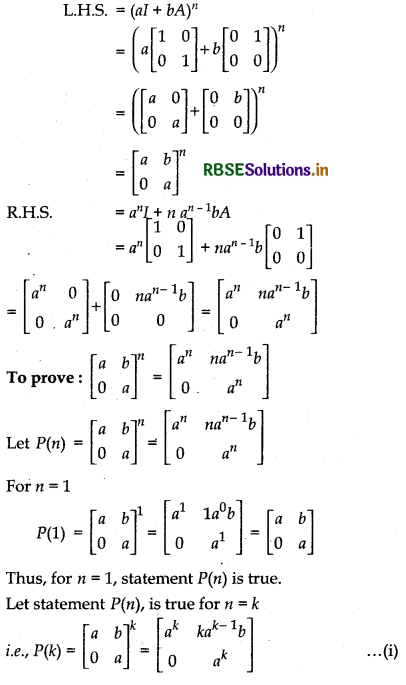
Now we will show that statement is true for n = k + 1 also i.e.,
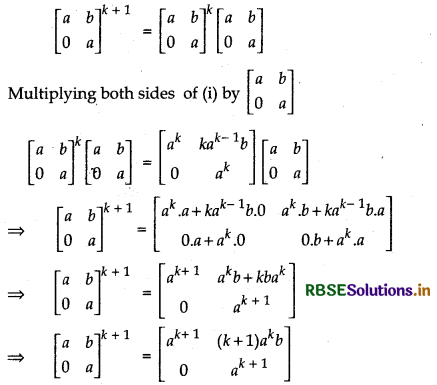
i.e., statement P(n) is true for n = k + 1.
Thus, according to principle of mathematical induction statement P(n) is true for ∀ n ∈ N.
⇒ \(\left[\begin{array}{ll} a & b \\ 0 & a \end{array}\right]^{n}=\left[\begin{array}{cc} a^{n} & n a^{n-1} b \\ 0 & a^{n} \end{array}\right]\)
∴ (aI + bA)n = anI + nan - 1bA
Hence Proved.

Question 2.
If A = \(\left[\begin{array}{lll} 1 & 1 & 1 \\ 1 & 1 & 1 \\ 1 & 1 & 1 \end{array}\right]\), then prove that An = \(\left[\begin{array}{lll} 3^{n-1} & 3^{n-1} & 3^{n-1} \\ 3^{n-1} & 3^{n-1} & 3^{n-1} \\ 3^{n-1} & 3^{n-1} & 3^{n-1} \end{array}\right]\), n ∈ N
Answer:
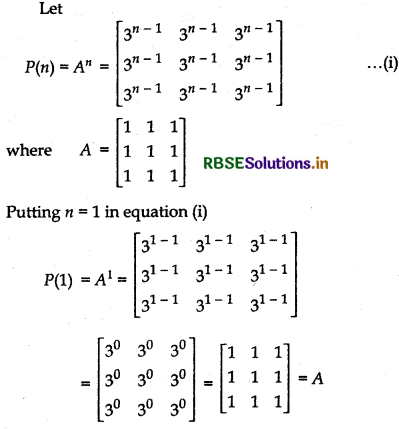
Thus, statement P(n), is true for n = 1
Let statement is true for n = k i.e.,
P(k) = Ak = \(\left[\begin{array}{lll} 3^{k-1} & 3^{k-1} & 3^{k-1} \\ 3^{k-1} & 3^{k-1} & 3^{k-1} \\ 3^{k-1} & 3^{k-1} & 3^{k-1} \end{array}\right]\)
Now , we will prove that the statement is true for n = k + 1 also.
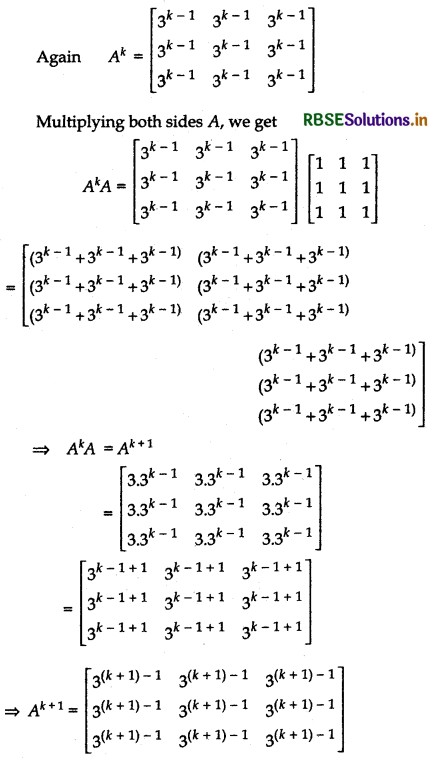
∴ Statement P(n), is true for n = k + 1, while it is true for n = k.
Thus, according to the principle of mathematical induction, given statement is true for all positive integer n ∈ N.
Hence Proved.

Question 3.
If A = \(\left[\begin{array}{ll} 3 & -4 \\ 1 & -1 \end{array}\right]\), then prove that An = \(\left[\begin{array}{cc} 1+2 n & -4 n \\ n & 1-2 n \end{array}\right]\), when n is any positive integer.
Answer:
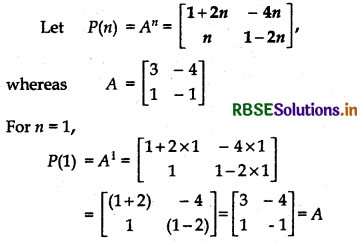
Thus, statement P(n), is true for n = 1.
Let statement is true for n = k, i.e.,
p(k) = Ak = \(\left[\begin{array}{cc} 1+2 k & -4 k \\ k & 1-2 k \end{array}\right]\) ......... (i)
Now, we will show that statement is true for n = k + 1, Multiplying both sides of Eq. (i) by A
AkA = Ak + 1
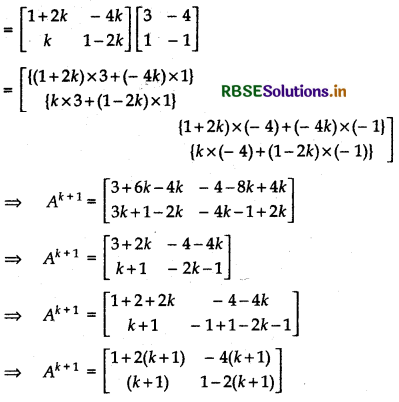
∴ Statement P(n) is true for n = k + 1 also, when it is true for n = k
Thus, according to principle of mathematical induction given statement is true for all positive integers n ∈ N.
Hence Proved.
Question 4.
If A and B are symmetric matrices, prove that AB - BA is a skew-symmetric matrix.
Answer:
We have, A and B are symmetric matrices.
So, A’ = A and B’ = B
(AB - BA)’ = (AB)’ - (BA)’ [∵ (X - Y)’ = X’ - Y’]
= B’A’ - A’B’ [∵ (XY)’ = Y’X']
= BA - AB (∵ A’ = A, B’ = B)
= - (AB - BA)
= skew-symmetric
Thus, (AB - BA) is a skew-symmetric matrix.
Hence Proved.

Question 5.
Show that matrix B’AB is symmetric or skew symmetric according as A is symmetric or skew-symmetric.
Answer:
(i) Let A is symmetric matrix, then
A’ = (-A)
∴ (B’ AB)’ = (B’(AB))’
= (AB)’ (B’)’ [By De Morgon’s law]
⇒ (B’AB)’ = (AB)’B [∵ (B')' = B']
⇒ (B’AB)’ = B’A’B [∵ (AB)' = B'A']
⇒ (B’AB)’ = B’AB [∵ A' = A]
⇒ (B’AB) is a symmetric matrix.
Hence proved
(ii) Let A is a skew-symmetric matrix.
∴ A’ = - A
Now (B’(AB))’ = (AB)’ (B’)’
= (B’A’)B (∵ (B')' = B)
= B’(- A)B (∵ A' = - A)
= - (B’AB)
∴ B’AB is a skew-symmetric matrix.
Hence Proved.
Question 6.
Find the values of x, y and z if matrix A = \(\left[\begin{array}{ccc} 0 & 2 y & z \\ x & y & -z \\ x & -y & z \end{array}\right]\) satisfies the equation A'A = I.
Answer:
We have
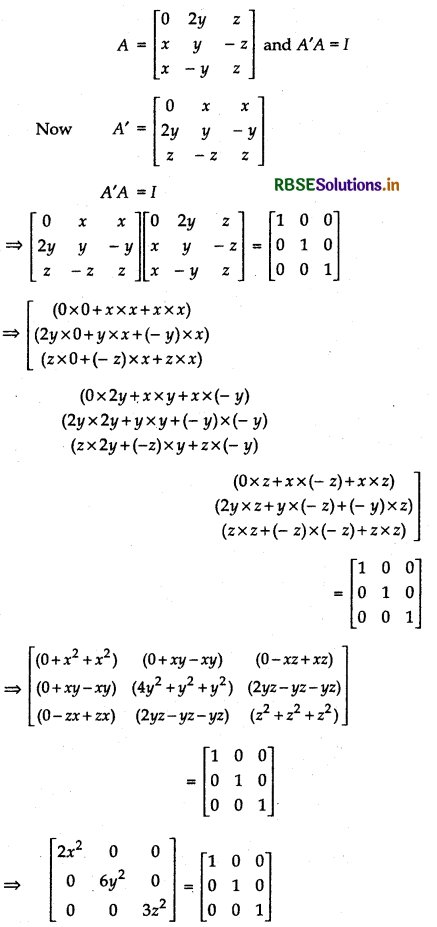
∴ Comparing corresponding elements in both sides.
2x2 = 1, 6y2 = 1, 3z2 = 1
∴ x = ±\(\frac{1}{\sqrt{2}}\), y = ±\(\frac{1}{\sqrt{6}}\), z = ±\(\frac{1}{\sqrt{3}}\)

Question 7.
For what values of x:
[1 2 1] \(\left[\begin{array}{lll} 1 & 2 & 0 \\ 2 & 0 & 1 \\ 1 & 0 & 2 \end{array}\right]\left[\begin{array}{l} 0 \\ 2 \\ x \end{array}\right]\) = 0?
Answer:
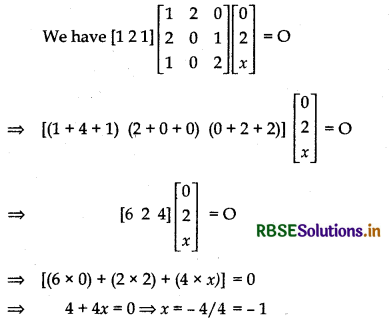
Question 8.
If A = \(\left[\begin{array}{rr} 3 & 1 \\ -1 & 2 \end{array}\right]\), show that A2 - 5A + 7I = 0
Answer:
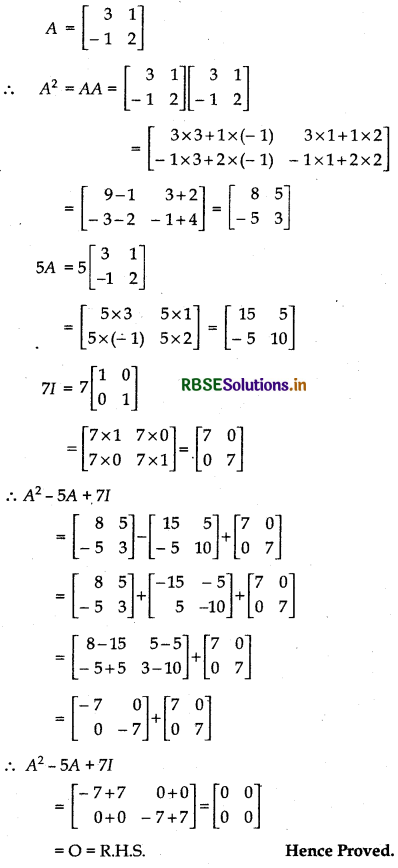

Question 9.
Find x, if
[x - 5 - 1] \(\left[\begin{array}{lll} 1 & 0 & 2 \\ 0 & 2 & 1 \\ 2 & 0 & 3 \end{array}\right]\left[\begin{array}{l} x \\ 4 \\ 1 \end{array}\right]\) = 0
Answer:
we have
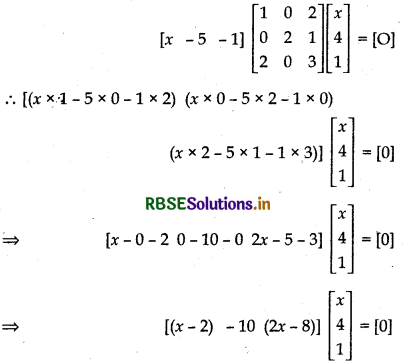
⇒ [(x - 2) × x - 10 × 4 + (2x - 8) × 1] = [0]
⇒ [x2 - 2x - 40 + 2x - 8] = [0]
⇒ x2 - 48 = 0
⇒ x2 = 48 ⇒ x2 = 16 × 3 ⇒ x = ± 4√3.
Question 10.
A manufacturer produces three products x, y, z which he sells in two markets. Annual sales are indicated below:

(a) If unit sale prices of x, y and z are ₹ 2.50, ₹ 1.50 and ₹ 1.00 respectively, find the total revenue in each market with the help of matrix algebra.
(b) If the unit costs of the above three commodities are ₹ 2.00, ₹ 1.00 and 50 paise respectively. Find the gross profit.
Answer:
Annual sales of products are as follows:
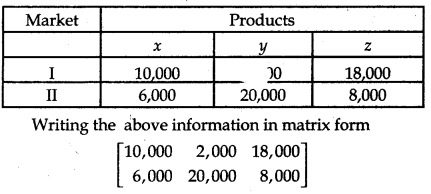
Sale prices of each unit of production x, y, z are ₹ 2.50, ₹ 1.50 and ₹ 1.00 respectively. Writing this in matrix form
\(\left[\begin{array}{l} 2.50 \\ 1.50 \\ 1.00 \end{array}\right]\)
(a) Income of both markets is obtained by multiplying both matrices. Thus,
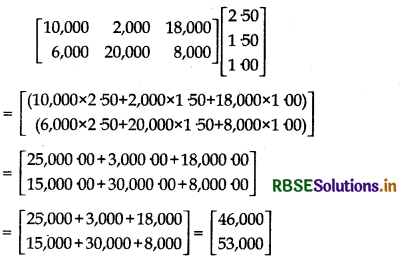
Thus, income from each market is ₹ 46,000 and ₹ 53,000.
(b) When unit costs of each product x, y, z are ₹ 2.00, ₹ 1.00 and ₹ 0.50, then writing them in matrix form.
\(\left[\begin{array}{l} 2.00 \\ 1.00 \\ 0.50 \end{array}\right]\)
Thus, cost price in market will be obtained as:
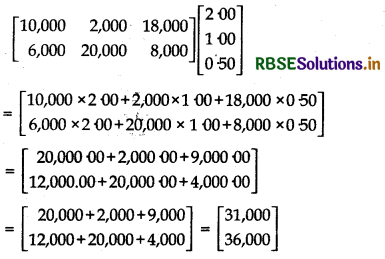
Profit of 1st market
= selling price - cost price
= 46,000 - 31,000 = ₹ 15,000
Profit of IInd market
= 53,000 - 36000 = ₹ 17,000

Question 11.
Find the matrix X so that X
X\(\left[\begin{array}{lll} 1 & 2 & 3 \\ 4 & 5 & 6 \end{array}\right]=\left[\begin{array}{rrr} -7 & -8 & -9 \\ 2 & 4 & 6 \end{array}\right]\)
Answer:
We have
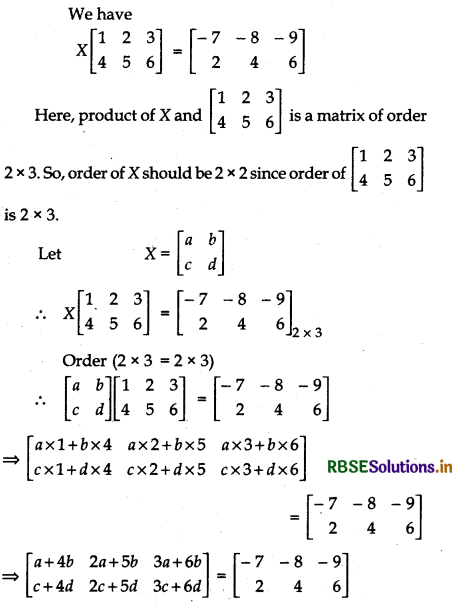
Comparing corresponding elements of both sides.
a + 4b = - 7 ...... (i)
2a + 5b = - 8 ....... (ii)
3a + 9 = - 9 ........... (iii)
c + 4d = 2 .......... (v)
2c + 5d = 4 ....... (v)
3c + 6d = 6 ........ (vi)
Multiply equation (i) by 2 and then subtracting equation
(ii) from it

Substituting value of b in euqation (iii), we get
3a + 6 × (- 2) = - 9
⇒ 3a - 12 = - 9
⇒ 3a = 12 - 9
⇒ 3a = 3
∴ a = 1
Multiplying Eq. (iv) by 2 and then substracting Eq. (v) from it
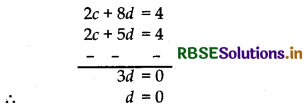
Putting value of d in equation (vi), we get
3c + 6 × 0 = 6
⇒ 3c =6
∴ c = 2
Now, putting values of a, b, c and d in \(\left[\begin{array}{ll} a & b \\ c & d \end{array}\right]\),
Thus, X = \(\left[\begin{array}{rr} 1 & -2 \\ 2 & 0 \end{array}\right]\)

Question 12.
If A and B are square matrices of the same order such that AB = BA, then prove by induction that ABn = BnA. Further, prove that (AB)n = AnBn for all n ∈ N.
Answer:
Let P(n) = ABn = BnA
where AB = BA
For n = 1
P(n) = AB1 = AB = BA (Given)
∴ For n = 1, statement P(n) is true
Let for n = k, statement is true, i.e.,
P(k) = ABk = BkA ....... (i)
Now, we will show that statement is true for n = k + 1 also.
Multiplying both sides of Eq. (i) by B.
L.H.S. = ABkB = ABk + 1
and R.H.S. = (BkA)B = Bk(AB) .
(By associativity of multiplication of matrices)
= Bk(BA) (∵ AB = BA)
= (BkB)A .
(By associativity of multiplication of matrices)
= Bk + 1A
∴ ABk + 1 = Bk + 1A (AB = BA, given)
⇒ P(n), is true for n = k + 1.
Thus, by the principle of mathematical induction, given statement is true for all positive integers n ∈ N.
Again, let P(n) : (AB)n = AnBn
Puffing n = 1
P(n):(AB)1 = A1B1
⇒ AB = AB
Thus, given statement is true for n = 1.
Let given statem. is true for n = k
i.e., P(k) : (AB)nk = AkBk .......... (ii)
Multiplying both sides of Eq. (ii) by AB.
L.H.S. = (AB)k (AB) = (AB)k + 1
R.H.S. = (AkBk) (AB) = AkBk (BA) (∵ AB = BA)
= Ak (BkB)A
(By associativity of multiplication of matrices)
= Ak (Bk + 1A)
= Ak (ABk + 1) [∵ ABk = BkA]
= (AkA) Bk + 1 = Ak + 1 Bk + 1
(By associativity of multiplication of matrices)
Thus (AB)k + 1 = k + 1 Bk + 1
∴ Given statement P(n), is true for n = k + 1 also it is true for n = k.
Thus, by the principle of mathematical induction, given statement is true for all positive integers n ∈ N.
Hence Proved.

Choose the correct answer in the following questions:
Question 13.
If A = \(\left[\begin{array}{rr} \alpha & \beta \\ \gamma & -\alpha \end{array}\right]\) is such that A2 = I, then:
(A) 1 + α2 + βγ = 0
(B) 1 - α2 + βγ = 0
(C) 1 - α2 - βγ = 0
(D) 1 + α2 - βγ = 0
Answer:
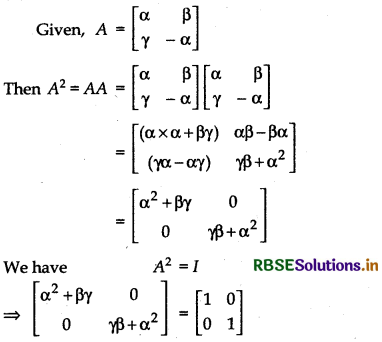
Comparing elements of both sides,
α2 + βγ = 1 or γβ + α2 = 1
∴ 1 - α2 - βγ = 0
Thus, option (C) is correct.
Question 14.
If the matrix A is both symmetric and skew-symmetric, then
(A) A is a diagonal matrix
(B) A is a zero matrix
(C) A is a square matrix
(D) None of these
Answer:
Let A = [aij]
For symmetric matrix
aij = aji ......... (i)
For skew-symmetric matrix
aij = - aji ........... (ii)
Since, given matrix is symmetric and skew-symmetric both. Thus, it will satisfy (i) and (ii) together.
Adding (i) and (ii),
aij + aij = aji - aji
⇒ 2ij = 0
⇒ aij = 0
∴ aij = aij = 0, (∀ i, j)
Thus, given square matrix is null matrix.
∴ Option (B) is correct.

Question 15.
If A is square matrix such that A2 = A, then (I + A)3 - 7A is equal to:
(A) A
(B) I - A
(C) I
(D) 3A
Answer:
We have
A2 = A
∵ A3 = A2A = AA
= A2 = A (∵ A2 = A, AA = A2)
∴ A3 = A
∵ (I + A)3 - 7A = I3 + 3I2A + 3IA2 + A3 - 7A
= I + 3A + 3A2 + A3 - 7A
[∵ (I + A)3 = (I + A) (I + A) (I + A)]
= I + 3A + 3A + A - 7A
= I + 7A - 7A = I
Thus, option (C) is correct.

- RBSE Class 12 Maths Notes Chapter 13 Probability
- RBSE Class 12 Maths Notes Chapter 12 Linear Programming
- RBSE Class 12 Maths Notes Chapter 11 Three Dimensional Geometry
- RBSE Class 12 Maths Notes Chapter 10 Vector Algebra
- RBSE Class 12 Maths Notes Chapter 9 Differential Equations
- RBSE Class 12 Maths Notes Chapter 8 Application of Integrals
- RBSE Class 12 Maths Notes Chapter 7 Integrals
- RBSE Class 12 Maths Notes Chapter 6 Application of Derivatives
- RBSE Class 12 Maths Notes Chapter 5 Continuity and Differentiability
- RBSE Class 12 Maths Notes Chapter 4 Determinants
- RBSE Class 12 Maths Notes Chapter 3 Matrices